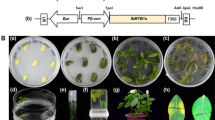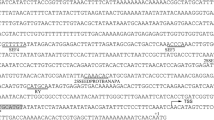Abstract
The seed protein IAP1 from bean (PvIAP1; Phaseolus vulgaris L.) that is modified by the phytohormone indole-3-acetic acid (IAA) was heterologously expressed in the two reference plant species Arabidopsis thaliana and Medicago truncatula. For the transformation of Medicago we devised a novel protocol using seedling infiltration. When PvIAP1 was overexpressed under the control of the constitutive 35SCaMV promoter in Arabidopsis, the plants showed signs of earlier bolting and enhanced branching. Expression of a fusion protein of PvIAP1 with both a green fluorescence protein (GFP) as reporter and 6× histidine (His) tag under the control of the native bean IAP1 promoter resulted in the accumulation of the protein in both plant species exclusively in seeds as shown by immunoblotting and by fluorescence microscopy. During seed development, PvIAP1 was first expressed in the vascular bundle of Arabidopsis, whereas in later stages GFP fluorescence was visible essentially in all tissues of the seed. Fluorescence decreased rapidly after imbibition in the seeds for both Arabidopsis and Medicago, although the fluorescence persisted longer in Arabidopsis. GFP fluorescence was distributed evenly between an organelle fraction, the microsomal membrane fraction, and the cytosol. This was also confirmed by immunoblot analysis. Clusters of higher GFP fluorescence were observed by confocal microscopy. Although PvIAP1 protein accumulated in seeds of both Arabidopsis and Medicago, neither species post-translationally modified the protein with an indoleacyl moiety as shown by quantitative GC–MS analysis after alkaline hydrolysis. These results indicate an apparent specificity for IAA attachment in different plant species.









Similar content being viewed by others
Abbreviations
- CaMV:
-
Cauliflower mosaic virus
- GC–MS:
-
Gas chromatography–mass spectrometry
- GFP:
-
Green fluorescent protein
- IAA:
-
Indole-3-acetic acid
- IAP:
-
IAA attached to protein
- LEA:
-
Late embryogenesis abundant
References
Bandurski RS, Schulze A (1977) Concentrations of IAA and its derivatives in plants. Plant Physiol 60:211–213
Bandurski RS, Cohen JD, Slovin JP, Reinecke DM (1995) Auxin biosynthesis and metabolism. In: Davies PJ (ed) Plant hormones: physiology, biochemistry and molecular biology, Ed 2. Kluwer, Boston, pp 39–65
Bartel B (1997) Auxin biosynthesis. Annu Rev Plant Physiol Plant Mol Biol 48:51–66
Battey NH, Dickinson HG, Hetherington AM (1993) Eds, In post translational modifications in plants. Cambridge University Press, Cambridge
Bialek K, Cohen JD (1986) Isolation and partial characterization of the major amide-linked conjugate of indole-3-acetic acid from Phaseolus vulgaris L. Plant Physiol 80:99–104
Bialek K, Cohen JD (1989a) Quantitation of indole acetic acid conjugates in bean seeds by direct tissue hydrolysis. Plant Physiol 90:398–400
Bialek K, Cohen JD (1989b) Free and conjugated indole-3-acetic acid in developing bean seeds. Plant Physiol 91:775–779
Bialek K, Michalczuk L, Cohen JD (1992) Auxin biosynthesis during seed germination in Phaseolus vulgaris. Plant Physiol 100:509–517
Boevink P, Oparka K, Santa Cruz S, Martin B, Betteridge A, Hawes C (1996) Virus-mediated delivery of the green fluorescent protein to the endoplasmic reticulum of plant cells. Plant J 10:935–941
Boisson-Dernier A, Chabaud M, Garcia F, Becard G, Rosenberg C, Barker DG (2001) Agrobacterium rhizogenes-transformed roots of Medicago truncatula for the study of nitrogen-fixing and endomycorrhizal symbiotic associations. Mol Plant Microbe Interact 14:695–700
Bowman J (ed) (1994) Arabidopsis: an atlas of morphology and development. Springer, New York
Cartharius K, Frech K, Grote K, Klocke B, Haltmeier M, Klingenhoff A, Frisch M, Bayerlein M, Werner T (2005) MatInspector and beyond: promoter analysis based on transcription factor binding sites. Bioinformatics 21:2933–2942
Chen K-H (1987) Analysis of indole-3-acetic acid in tobacco genetic tumors and wheat GA3 insensitive mutant “Tom Thumb”. Ph.D. Dissertation, University of Maryland, College Park
Cholodny N (1935) Über das Keimungshormon von Gramineen. Planta 23:289–312
Clough SJ, Bent AF (1998) Floral dip: a simplified method for Agrobacterium-mediated transformation of Arabidopsis thaliana. Plant J 16:735–743
Cohen JD (1983) Metabolism of indole-3-acetic acid. Plant Physiol 14:41
Cohen JD (1984) Convenient apparatus for the generation of small amounts of diazomethane. J Chromatogr 303:193–196
Cohen JD, Baldi BG, Slovin JP (1986) 13C6-[benzene ring]—Indole-3-acetic acid. Plant Physiol 80:14–19
Cohen JD, Slovin JP, Bialek K, Chen K-H, Derbyshire M (1988) Mass spectrometry, genetics and biochemistry: understanding the metabolism of indole-3-acetic acid. Beltsville symposia on agricultural research 12. In: Steffens GL, Rumsey TS (eds) Biomechanisms regulating growth and development. Kluwer, Dordrecht, pp 229-241
Cohen JD, Baldi BG, Baraldi R, Bialek K, Chen K-H, Slovin JP (1989) Genetic and analytical techniques for auxin studies. Giornale Botanico Italiano 123:355–365
Cohen JD, Ilic N, Taylor R, Dunlap JR, Slovin JP (1995) Auxin localization and metabolism during fruit growth and ripening in cantaloupe. In: Lester GE, Dunlap JR (eds) Proc Cucurbitaceae. Gateway, Edinburg, TX, pp 104–109
Crane C, Wright E, Dixon RA, Wang Z-Y (2006) Transgenic Medicago truncatula plants obtained from Agrobacterium tumefaciens-transformed roots and Agrobacterium rhizogenes-transformed hairy roots. Planta 223:1344–1354
del Pozo JC, Estelle M (1999) Function of the ubiquitin-proteosome pathway in auxin response. Trends Plant Sci 4:107–112
Epstein E, Cohen JD, Bandurski RS (1980) Concentration and metabolic turnover of indoles in germinating kernels of Zea mays L. Plant Physiol 65:415–421
Gunning BES (1998) The identity of mystery organelles in Arabidopsis plants expressing GFP. Trends Plant Sci 3:417
Hamilton RH, Bandurski RS, Grigsby BH (1961) Isolation of indole-3-acetic acid from corn kernels and etiolated corn seedlings. Plant Physiol 36:354–359
Hawes C, Saint-Jore C, Martin B, Zheng H-Q (2001) ER confirmed as the location of mystery organelles in Arabidopsis plants expressing GFP. Trends Plant Sci 6:245–246
Hellens RP, Edwards EA, Leyland NR, Bean S, Mullineaux PM (2000) pGreen: a versatile and flexible binary Ti vector for Agrobacterium-mediated plant transformation. Plant Mol Biol 42:819–832
Higo K, Ugawa Y, Iwamoto M, Korenaga T (1999) Plant cis-acting regulatory DNA elements (PLACE) database. Nucleic Acids Res 27:297–300
Hood EE, Gelvin SB, Melchers LS, Hoekema A (1993) New Agrobacterium helper plasmids for gene transfer to plants. Transgenic Res 2:208–218
Kamaté K, Rodriguez-Llorente ID, Scholte M, Durand P, Ratet P, Kondorosi E, Kondorosi A, Trinh TH (2000) Transformation of floral organs with GFP in Medicago truncatula. Plant Cell Rep 19:647–653
Kyte J, Doolittle RF (1982) A simple method for displaying the hydropathic character of a protein. J Mol Biol 157:105–142
Lazo GR, Stein PA, Ludwig RA (1991) A DNA transformation–competent Arabidopsis genomic library in Agrobacterium. Biotechnology 9:963–967
Leyser O (1998) Auxin signalling: protein stability as a versatile control target. Curr Biol 8:R305–R307
Oetiker JH, Aeschbacher G (1997) Temperature-sensitive plant cells with shunted indole-3-acetic acid conjugation. Plant Physiol 114:1385–1395
Östin A, Kowalyczk M, Bhalerao RP, Sandberg G (1998) Metabolism of indole-3-acetic acid in Arabidopsis. Plant Physiol 118:285–296
Park S, Cohen JD, Slovin JP (2006) Strawberry fruit protein with a novel indole-acyl modification. Planta 224:1015–1022
Penmetsa RV, Cook DR (1997) A legume ethylene-insensitive mutant hyperinfected by its rhizobial symbiont. Science 275:527–530
Penny P (1971) Growth-limiting proteins in relation to auxin-induced elongation in lupin hypocotyls. Plant Physiol 48:720–723
Percival FW, Bandurski RS (1976) Esters of indole-3-acetic acid from Avena seeds. Plant Physiol 58:60–67
Piskornik A, Bandurski RS (1972) Purification and partial characterization of a glucan containing indole-3-acetic acid. Plant Physiol 50:176–182
Prestridge DS (1991) SIGNAL SCAN: a computer program that scans DNA sequences for eukaryotic transcriptional elements. CABIOS 7:203–206
Quandt K, Frech K, Karas H, Wingender E, Werner T (1995) MatInd and MatInspector: new fast and versatile tools for detection of consensus matches in nucleotide sequence data. Nucleic Acids Res 23:4878–4884
Ribnicky DM, Cohen JD, Hu W-S, Cooke TJ (2002) An auxin surge following fertilization in carrots: a mechanism for regulating plant totipotency. Planta 214:505–509
Ridge RW, Uozumi Y, Plazinski J, Hurley UA, Williamson RE (1999) Developmental transitions and dynamics of the cortical ER of Arabidopsis cells seen with green fluorescent protein. Plant Cell Physiol 40:1253–1261
Rombauts S, Dehais P, Van Montagu M, Rouze P (1999) PlantCARE, a plant cis-acting regulatory element database. Nucleic Acids Res 27:295–296
Sambrook J, Fritsch EF, Maniatis T (1989) Molecular cloning, a laboratory manual. Eds, Cold Spring Harbour Laboratory Press, New York
Seidel C, Walz A, Park S, Cohen JD, Ludwig-Müller J (2006) Indole-3-acetic acid protein conjugates: novel players in auxin homeostasis. Plant Biol 8:340–345
Slovin JP, Bandurski RS, Cohen JD (1999) Auxin. In: Hooykaas PJJ, Hall MA, Libbenga KR (eds) Biochemistry and molecular biology of plant hormones. Elsevier, Amsterdam, The Netherlands, pp 115–140
Stewart CN Jr (2001) The utility of green fluorescent protein in transgenic plants. Plant Cell Rep 20:376–382
Sztein AE, Cohen JD, Garcia de la Fuente I, Cooke TJ (1999) Auxin metabolism in mosses and liverworts. Am J Bot 86:1544–1555
Tam YY, Epstein E, Normanly J (2000) Characterisation of auxin conjugates in Arabidopsis. Low steady-state levels of indole-3-acetyl-aspartate, indole-3-acetyl-glutamate and indole-3-acetyl-glucose. Plant Physiol 123:589–595
Trieu AT, Burleigh SH, Kardailsky IV, Maldonado-Mendoza IE, Versaw WK, Blaylock LA, Shin H, Chiou TJ, Katagi H, Dewbre GR, Weigel D, Harrison MJ (2000) Transformation of Medicago truncatula via infiltration of seedlings or flowering plants with Agrobacterium. Plant J 22:531–541
Tsurumi S, Wada S (1986) Identification of 3-hydroxy-2-indolone-3-acetylaspartic acid as a new indole-3-acetic acid metabolite in Vicia seedlings. Plant Cell Physiol 27:599–562
van Overbeek J (1941) A quantitative study of auxin and its precursor. Am J Bot 28:1–10
Vieweg MF, Frühling M, Quandt H-J, Heim U, Bäumlein H, Pühler A, Küster H, Perlick AM (2004) The promoter of the Vicia faba L. leghemoglobin gene VfLb29 is specifically activated in the infected cells of root nodules and in the arbuscule-containing cells of mycorrhizal roots from different legume and nonlegume plants. Mol Plant Microbe Interact 17:62–69
Walz A, Park S, Slovin JP, Ludwig-Müller J, Momonoki YS, Cohen JD (2002) A gene encoding a protein modified by the phytohormone indoleacetic acid. Proc Natl Acad Sci USA 99:1718–1723
Weeks JT, Ye J, Rommens CM (2007) Development of an in planta method for transformation of alfalfa (Medicago sativa). Transgen Res. doi:10.1007/s11248-007-9132-9
Ye G-N, Stone D, Pang S-Z, Creely W, Gonzalez K, Hinchee M (1999) Arabidopsis ovule is the target for Agrobacterium in planta vacuum infiltration transformation. Plant J 19:249–267
Acknowledgments
This work was supported by a grant from the Deutsche Forschungsgemeinschaft within SPP 1067 to J.L.-M. (Lu500/8), a grant from the German Ministry for Science and Education (WTZ grant HRV 01/025) to J.L.-M and G.R., grants from the National Science Foundation (IBN 01-11530 and DBI 06-06666) to J.D.C. and support from the Minnesota Agricultural Experiment Station and the Gordon and Margaret Bailey Endowment for Environmental Horticulture. We thank Dr. David Mok for the gift of the genomic library from bean and Dr. Cesar V. Mujer for critical reading of the manuscript. The help with Confocal Laser Scanning Microscopy by Dr. Hella Hartmann, BIOTEC, Technische Universität Dresden is gratefully acknowledged.
Author information
Authors and Affiliations
Corresponding author
Additional information
Alexander Walz and Claudia Seidel contributed equally to the paper.
Rights and permissions
About this article
Cite this article
Walz, A., Seidel, C., Rusak, G. et al. Heterologous expression of IAP1, a seed protein from bean modified by indole-3-acetic acid, in Arabidopsis thaliana and Medicago truncatula . Planta 227, 1047–1061 (2008). https://doi.org/10.1007/s00425-007-0679-8
Received:
Accepted:
Published:
Issue Date:
DOI: https://doi.org/10.1007/s00425-007-0679-8




